Lamborghini Temerario
The Lamborghini Temerario is in a class of its own. It is the spiritual successor to the Huracán and a 920 CV twin-turbo V8 hybrid monster.
 Photos by Automobili Lamborghini S.p.A.
Photos by Automobili Lamborghini S.p.A.
Automobili Lamborghini unveiled the Temerario, the legendary Italian marque's new twin-turbo V8 hybrid super sports car, at The Quail, A Motorsports Gathering, the highlight of the annual Monterey Car Week in California. Succeeding the Huracán, the Temerario sets a new benchmark for the super sports car segment with a total power output of 920 CV, reaching a top speed of more than 210 mph (over 340 km/h) and accelerating from 0-62 mph (0-100 km/h) in 2.7 seconds. The Temerario is the second Lamborghini HPEV (High-Performance Electrified Vehicle) and the third step in the electrification strategy for the company, completing the hybridization of the entire Lamborghini lineup following the Revueltoand the Urus SE.
The Temerario replaces the Lamborghini Huracán, which debuted in 2014 and has been the greatest-selling super sports car in the history of the Sant'Agata Bolognese-based carmaker. As stated by Stephan Winkelmann, Chairman and Chief Executive Officer of Automobili Lamborghini, "Every new Lamborghini must surpass its forerunners in performance terms." With the Temerario, the new hybrid plug-in reaches a new paradigm in terms of performance, sportiness, and driving pleasure. The Temerario is the first and only production super sports car engine able to reach 10,000 rpm: a feat typically only achieved in motorsports.
With the Temerario, we've exceeded our expectations with what the mid-engine sports car can be in terms of performance and design. The Temerario completes the next chapter in our Direzione Cor Tauri plan by hybridizing the full product line while we continue the development of our full electric model debuting at the end of the decade.
Stephan Winkelmann
In addition to the Temerario, the full hybrid product line took center stage at the annual automotive event, including the flagship Revuelto and super SUV Urus SE. The Revuelto features a 6.5-liter V12 mid-engine with 1,015 CV and a top speed of 217 mph (over 350 km/h). The Urus SE features a twin-turbo 4.0-liter V8 engine, which delivers a total output of 800 CV and reaches a top speed of 194 mph (312 km/h).
Alongside its global unveiling, the Temerario made its virtual debut in the Lamborghini Lab, the official design and driving experience on Roblox, created by Automobili Lamborghini to inspire new generations. In the virtual realm, you can customize your Temerario using colors and options from Lamborghini's Ad Personam studio. Experience unparalleled performance as you take your customized supercar on the track, competing with friends and challengers worldwide.
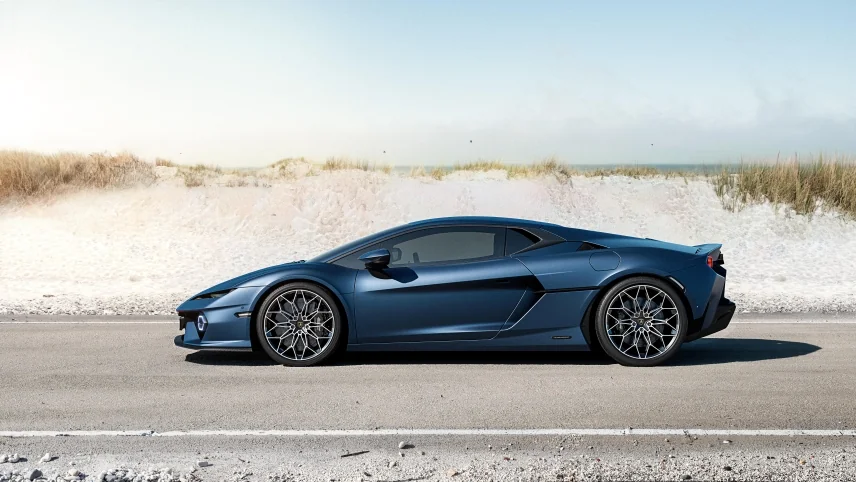
Powertrain
The heart of a Lamborghini has always been its drive system. After several years of development, Lamborghini takes an entirely new approach with the new Temerario, delivering an unprecedented super sports car powertrain comprised of an extremely high-revving biturbo Internal Combustion Engine concept combined with three electric motors.
The new powertrain is integral to the second super sports car in Lamborghini's High-Performance Electrified Vehicle (HPEV) product range. The first target was to achieve the highest possible power and torque while at the same time offering the response of a classic high-revving naturally aspirated engine. Therefore, only high-performance components are used in the drivetrain: the new 4.0-liter V8 biturbo engine has a specific output of 200 CV per liter. It works together with an oil-cooled axial flow electric motor that is fully integrated into the V8 housing. Propulsion is supported by two electric motors on the front axle.
The new engine with the internal designation L411 is now one of the most powerful engines in the segment. The V8 biturbo delivers its peak power of 800 CV from 9,000 to 9,750 rpm and 730 Nm of torque between 4,000 and 7,000 rpm. The electric motor, in the P1 position (between the V8 engine and the gearbox), ensures immediate response starting from low engine speed and continues consistently through gear shifts, working as a “torque gap filler” and improving the transient response, giving the sensation of linear and limitless progression up to 10,000 revs. Thanks to the two large turbochargers, efficiency and performance are increased at top speeds. These are located compactly in the V of the engine as a “hot V8” to optimize the packaging and thermal management. The V8 biturbo can rev up to 10,000 revolutions per minute; the maximum boost pressure of the turbochargers is 2.5 bar (abs). The turbines are controlled with an electrical wastegate and a wheel-speed sensor. Lamborghini has designed air filter boxes with tubular cartridges, making them extremely compact to create space and become even more efficient.
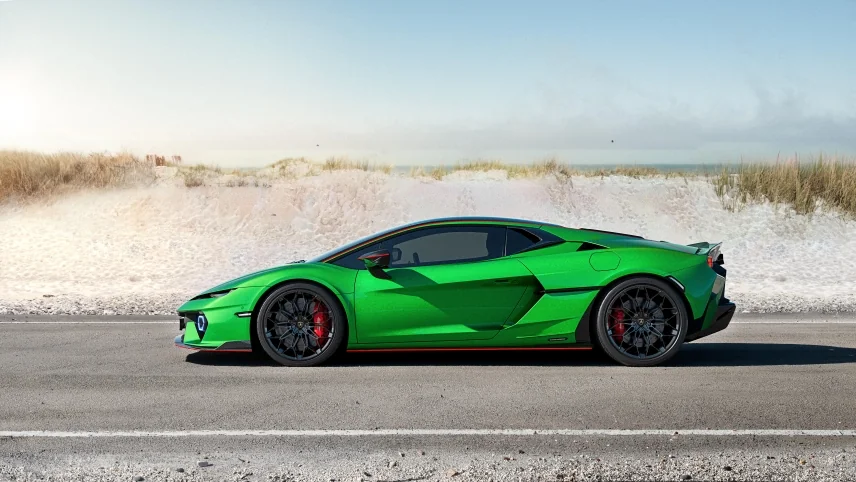
At the heart of the crankshaft housing is a flat-plane crankshaft with a 180-degree angle between the crankshaft bends. This crankshaft, which is typically used in racing engines, ensures optimal fluid-dynamic behavior due to even firing orders compared to the cross-plane crankshaft and a unique engaging sound. Titanium conrods reduce the rotating masses and offer excellent material properties in terms of strength and lightness, reducing weight. The engine casting material consists of A357+Cu, the same used in motorsport applications.
The particularly robust and reliable finger followers covered in DLC (Diamond Like Carbon) can withstand speeds of up to 11,000 revolutions per minute - a range previously reserved for racing engines in motorsport. This is also where the engineers drew their inspiration for the engine layout concept. As is usual in motorsport, most of the auxiliary units are located on one side, including the two water pumps for the intercooler and engine cooling, as well as the electronically-controlled barrel valve for fine temperature control.
The oil and water pumps, which are arranged in series on the right-hand side of the engine, are driven up to a specific ratio pump speed of 7,800 rpm. The engineers integrated the oil tank in one side of the engine that works according to the dry sump principle with five-stage gear scavenge pumps. As a result, the drive unit is flat and sits low in the Temerario, lowering the vehicle's center of gravity while improving its handling characteristics. A newly designed water-cooling system ensures a balanced temperature regime. The internal cooling of the cylinder heads has been extremely refined using 3D printing technology for the casting core, allowing a uniform cooling of the combustion chamber and high knock resistance. The direct petrol injection atomizes the fuel extremely finely into the eight combustion chambers at up to 350 bar, thus ensuring fast and clean combustion.
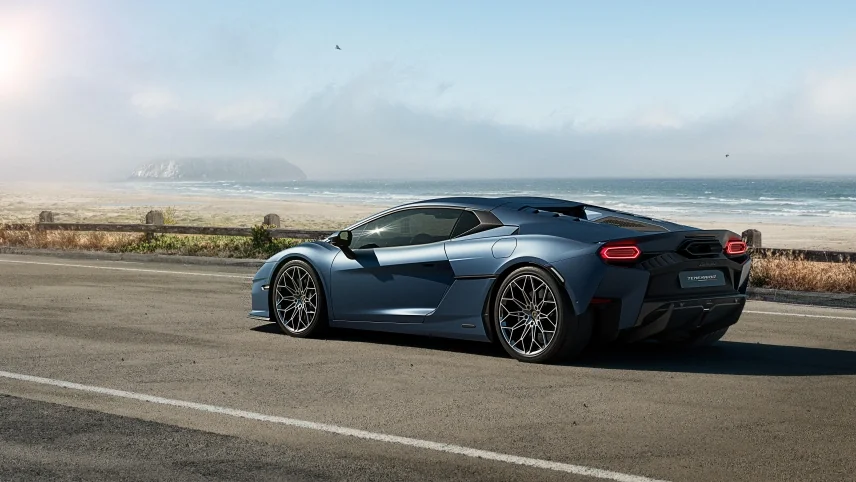
The characteristics of a smoothly revving, naturally aspirated engine, with the power delivery of a turbo engine in combination with electric drives, are unique in the way it works and sounds. Lamborghini has thus succeeded in developing a new V8 biturbo that combines the pronounced linearity of the rev development in the previous Lamborghini naturally aspirated V10 with the enormous power and torque of a modern turbo engine. The system output is an outstanding 920 CV / 676 kW in conjunction with the three electric motors.
Three electric motors for support
The new drivetrain incorporates three electric motors. With 110 kW of power each, the electric motors are an integral part of the powertrain strategy. Two oil-cooled axial flow electric motors with a total peak output of 220 kW and up to 2,150 Nm of torque (the continuous output is 60 kW) drive the front axle when required to achieve all-wheel drive. The electric front axle weighs just 73 kilograms, and each electric motor weighs only 15.5 kilograms.
A major challenge was designing the powertrain to be as compact as possible. To achieve this, the engineers integrated the electric motor directly into the housing of the V8 biturbo without an intermediate clutch. This fills any turbo lag, no matter how small, at any speed, delivering 300 Nm of torque. The entire electric drive unit is located compactly between the combustion engine and the dual-clutch transmission.
This electric motor also works as a starter motor and three-phase generator. Furthermore, the two electric motors on the front axle also improve the power output and can transform the new Temerario into a fully electric super sports car. In this way, Lamborghini reduces CO2 emissions by up to 50 percent compared to the Huracán.
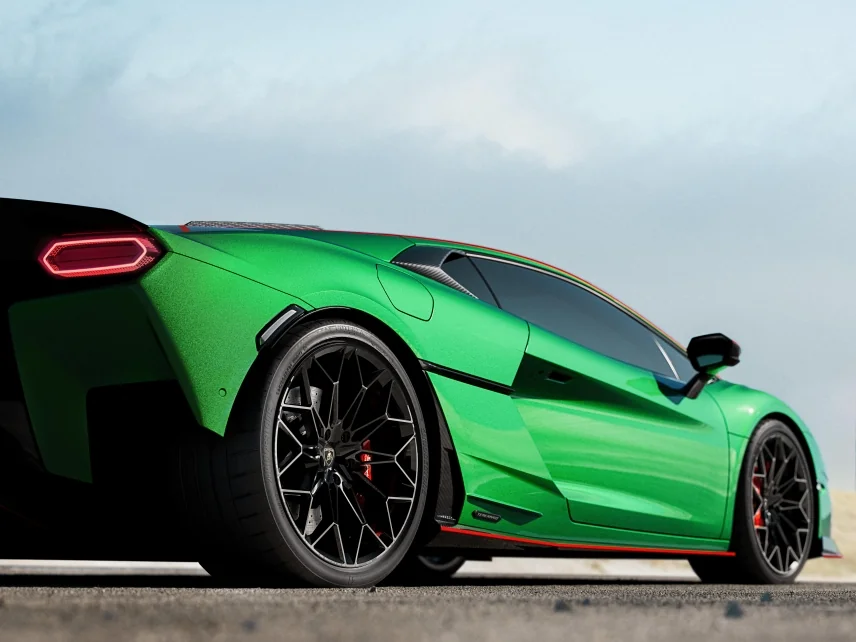
Dual-clutch transmission
The gears of the second Lamborghini super sports car in the High-Performance Electrified Vehicle (HPEV) category are shifted by an eight-speed dual-clutch transmission (DCT) installed transversally behind the V8. The newly designed compact transmission meets all the requirements of such a powerful drive unit.
The layout is not a standard DTC to save installation space and weight. An additional hollow shaft shares the same synchronizers for different gear torque paths. Without electrical components, the new DCT weighs less than the Huracán's seven-speed dual-clutch transmission and achieves faster shift times. At 560 millimeters long, 750 millimeters wide, and just 580 millimeters high, the new DCT also remains exceptionally compact.
Lamborghini has installed the new eight-speed dual-clutch transmission behind the V8 biturbo. This creates sufficient space in the center tunnel for the lithium-ion battery that powers the electric motors. Another advantage is that this technical layout optimizes the Temerario's weight distribution and ensures a compact wheelbase for ideal driving dynamics and balanced handling.
With the new eight-speed dual-clutch transmission, drivers experience extremely fast shift times, even with a sporty and daily driving style. Continuous downshifts, in particular, are easy. When braking and simultaneously pressing and holding the left shift paddle, the transmission shifts down gears sequentially, allowing the driver to feel and hear the gear change. The long ratio eighth gear reduces the engine speed, which helps to optimize fuel consumption and improves drivability at cruising speed. The Temerario gearbox has been equipped with a mechanical reverse gear system.
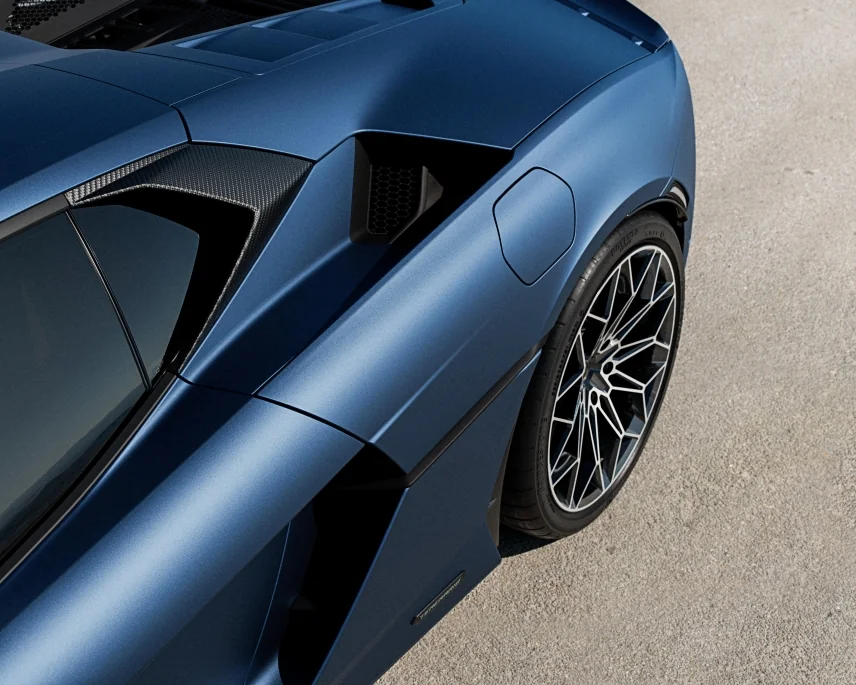
Exteriors
At first glance, the Temerario reveals Lamborghini DNA in its typical Lamborghini silhouette: clear and puristic lines, short and compact overhangs, integrated aerodynamics, and a bold shark nose.
The Lamborghini design language has evolved to create a new hexagonal Daytime Running Light (DRL) signature, rendering it strongly recognizable and identifiable from far away. The hexagon concept is the main design theme throughout the car: on the main bodywork, the side air intakes, the taillights, and the remarkable hexagonal exhaust pipe. The geometric hexagon paradigm has been one of Lamborghini's most recognizable symbols since the 1960s.
The hexagonal daytime running lights, which incorporate an air tunnel, are part of the design philosophy of incorporating lights within the aerodynamic concept. Furthermore, air channels positioned below the headlights improve the aero performance and cooling of the front high-performance braking system for better efficiency.

The Temerario's designers combine elements from aviation with a visceral muscularity that starts at the front. The design is characterized by well-formed athletic surfaces and a cabin that tapers towards the hexagonal tailpipes. The tip of the hood dominates the entire front end in a strong and striking shark's nose design: a symbol of bravery and speed. The sharp, elegant headlights are slightly overlapped by the hood, drawing inspiration from the sports motorcycle world. Air-guiding slats connect the low front spoiler with the hood, while fins on the sides direct the airflow along the flanks. Sharply-shaped side skirts support the aerodynamics and increase downforce at the same time.
With a broad shoulder and long, powerful muscularity, the side stretches from the front over the door, emphasizing the extreme sportiness of the Temerario. The powerful and efficient air intakes behind the side doors ensure the necessary airflow for the V8 bi-turbo's performance and, at the same time, visually enhance the chassis' downforce. A fixed rear spoiler emphasizes the car's rear width. The compact yet technical rear end incorporates motorsport details, such as the wide diffuser that extends under the vehicle and the integrated exhaust tailpipes. The rear lights feature the new hexagonal design, also allowing air to pass through for engine cooling.
The roof is also functional in terms of aerodynamics. A slightly rearward offset profile directs the air directly onto the integrated rear wing. The designers almost invisibly integrated air inlets behind the passenger compartment above the sculpted shoulder: a highly functional component that helps supply the engine, radiator, and turbocharger with sufficient air.
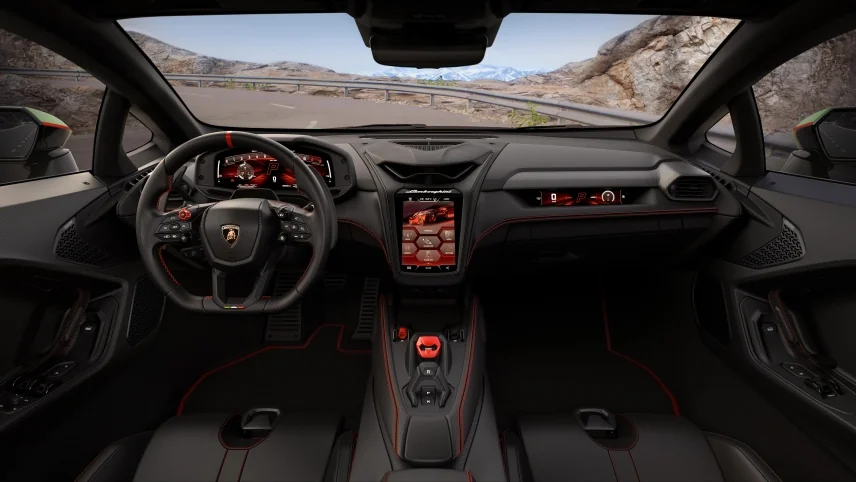
Interiors
The interior mirrors the extraordinary exterior design, balancing digital and physical experiences. Lamborghini uses best-quality materials such as carbon, leather, and Corsatex by Dinamica suede throughout the interior, combining them to create a high-quality interior experience with a unique feel. Many interior elements can also be ordered in carbon fiber as an option, including parts of the center console, air vents, door panels, parts of the dashboard, steering wheel, and steering column. In addition to the elegant, lightweight materials, customers can find classical Lamborghini elements such as the Start/Stop “Power button” inspired by aviation, the e-gear lever, and the red line-up indicator on the steering wheel to emphasize the extreme sportiness of the Temerario.
Following the "Feel like a pilot" philosophy, the new-generation dashboard quickly makes the pilot and co-pilot one with the car. Clear and intuitive to operate, the pilot can reach all the controls from their perfect seat position. Iconic hexagonal air vents are elegantly integrated into the cockpit, and the center console has space for a smartphone and wallet.
The newly developed steering wheel with optional carbon elements is inspired by the racing world and allows the driver to control the main driving functions. On the left-hand side of the steering wheel is the red-crowned rotor, which is used to select driving modes. Below these are buttons for the lift function to raise the vehicle, the ‘race start' button, and the switches for the indicators. The driver can operate Launch Control with a simple touch of a button for maximum control.
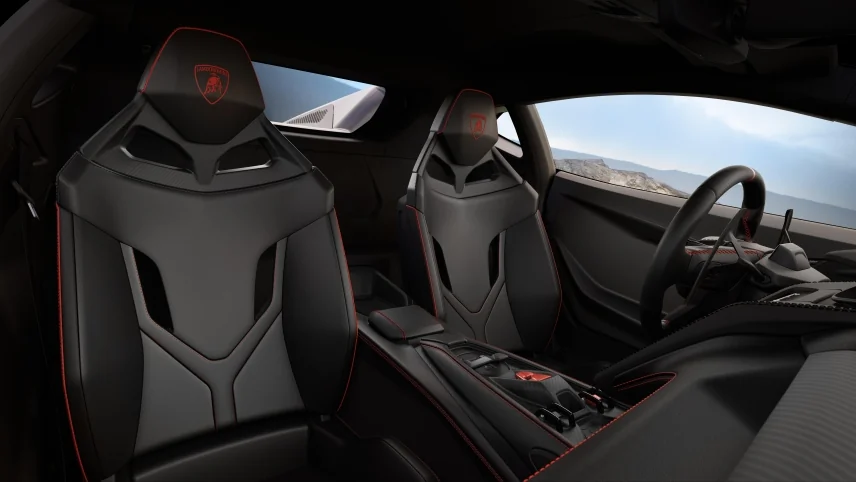
Technical Specifications
Powertrain
Engine: V8 Bi-Turbo - Hot-V 4.0l
Displacement: 3995,2 cm3 (243,8 cu in)
Bore and Stroke: 90 mm x 78,5 mm (3,54 x 3,09 in)
Compression Ratio: 1:9,3
Max power @ rpm (ICE): 800 CV @ 9000-9750 rpm
Max power (combined ICE+EE): 920 CV
Max torque @ rpm (ICE): 730 Nm @ 4000-7000 rpm
Cooling System: Liquid-cooled - dedicated circuit for HV components
Engine Management System: Central DI - Bosch
Lubrication System: Dry sump
Transmission
Transmission: Automatic
Gearbox: 8 gears
Clutch: Dual clutch
Hybrid System
Battery: Lithium-ion high-specific power battery with pouch cells
Generator: P1 eMotor
Front e-axle: 220kW @3500rpm
Performance
Max Speed: 343 km/h
Acceleration 0-100 km/h: 2.7 s
Braking 100-0 km/h: 32 m
Body and chassis
Frame: Full Aluminium
Body: Aluminium
Wheels
Tyres – Front: Bridgestone Potenza Sport 255/35 ZR20
Tyres – Rear: Bridgestone Potenza Sport 325/30 ZR21
Front Rims: 20 x 9J
Rear Rims: 21 x 11.5J
Braking system
Brakes: CCB Plus (Carbon Ceramic Brakes Plus) brakes with fixed monoblock calipers in
aluminum with 10 pistons (front) and 4 pistons (rear)
Front Brakes: 410x38mm discs
Rear Brakes: 390x32mm discs
Dimensions
Wheelbase: 2.658 mm (104,6457 in.)
Lenght: 4.706 mm (185,2756 in.)
Width (Excluding Mirrors): 1.996 mm (78,58268 in.)
Width (Including Mirrors): 2.246 mm (88,4252 in.)
Height: 1.201 mm (47,28346 in.)
Dry Weight: 1.690 kg (3.725,8 lb)
Weight-to-power Ratio: 1,84 kg/CV
Find more Cars
The Porsche Panamera gets more power
Porsche is completing the product line-up for the new Porsche Panamera with...
Aston Martin Valiant
An ultra-exclusive, track-focused, road-legal extreme Aston Martin Valiant ...
Bruno Senna to Mentor the Mclaren P1 GTR driver pr...
Former Formula 1 and current McLaren GT factory driver Bruno Senna has join...
Bugatti Centodieci - The 8 million EURO car
The next phase is about to start for the hyper sports car with a W16 engine...
The Rolls-Royce Koa Phantom
The Koa Phantom is the first Rolls-Royce Phantom that incorporates Koa Wood...
Porsche 911 Speedster
The Porsche 911 Speedster already caused a sensation when it was presented ...




















